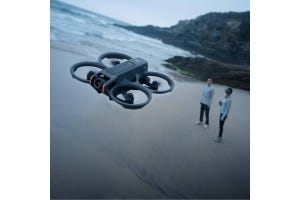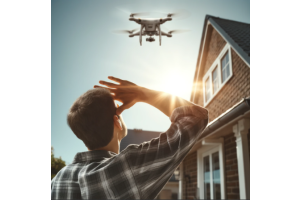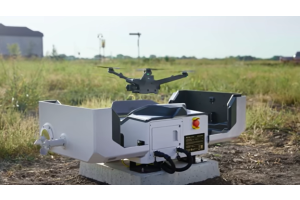It was initially announced and compliance expected from September 2023
It was delayed for 6 months.
And now it’s in force.
It’s been a timeline filled with plenty of back and forth. With the non-enforcement period of Federal Aviation Administration (FAA)'s Remote ID rule having expired on March 16, both drone manufacturers and operators must now get compliant.
Quick Recap: What Is Remote ID?
Remote ID functions like digital license plate for UAVs, enabling real-time broadcast of identifying and positional information of drones in flight. That way, the FAA, law enforcement, and other federal agencies can easily identify drones, separating authorized operations from potentially unsafe or unauthorized ones. And given that there are over 1 million drones currently registered in the US and nearly 3.5 million in use, its importance in promoting safe and responsible drone use cannot be emphasized enough.
Full Guide on How It Works, And How to Comply Here: Understanding the FAA's Remote ID Rule for Drones
Compliance Landscape: A Mixed Bag
Despite the deadline extension to give manufacturers and pilots time to prepare, it hasn’t been smooth sailing. A study by SkySafe, a drone tracking and intelligence firm, has some interesting findings on the varied readiness levels of major drone makers in implementing standard Remote ID technology.
Out of seven manufacturers assessed, only Skydio was found to fully comply with the Remote ID specifications, using WiFi Beacon-based broadcasts across all existing models in its lineup.
DJI, one of the titans in the industry, has faced some challenges with its WiFi Beacon Remote ID feature in drones, particularly with inconsistent location and altitude reporting due to various firmware updates. This has made drone tracking unpredictable. In a surprising turn of events reported in February, DJI's Mini 3 and Mini 4 Pro drones began to skip Remote ID signals in their standard mode, making them non-compliant under usual Remote ID rules, especially when flown with standard batteries that keep the drone under 250g. This isn't an issue for hobbyists but creates compliance problems for professional Part 107 pilots. To stay compliant, these pilots can either switch to heavier batteries to automatically enable Remote ID or attach an external Remote ID module. DJI has clarified that their compliance statements specifically apply to setups with the heavier batteries. However, this raises a compliance concern under the ASTM F3411 - 22a standards, which demand consistent Remote ID broadcasting, indicating that disabling it could breach FAA standards.
On the other hand, manufacturers such as Autel have had an arguably problematic implementation. Initially, Autel experimented with a WiFi NaN system in their drone firmware but later shifted to using misconfigured WiFi Beacons with a universal MAC address and a generic SSID name. Additionally, the capability to enable or disable Remote ID varies with the drone's firmware version, and some models allow pilots to turn off this feature through the app. The serial numbers on Autel drones further complicate matters, with inconsistencies in prefix accuracy and length across different models and firmware versions, including serial numbers with 12, 17, and 20 characters. Some serial numbers even include invalid characters like "O," which contradicts ANSI/CTA-2063 standards and complicates FAA registration. Moreover, certain firmware versions report incorrect elevation data, presenting a reversed elevation profile.
SkySafe's analysis over a 30-day-period using their sensor network revealed that 50% of Autel drones broadcast non-compliant 12-character serial numbers, 25% included the invalid "O" character, and the rest varied between 17 and 20 characters in length, highlighting widespread compliance challenges.
Parrot has some catching up to do with its Remote ID tech, which uses WiFi Beacon signals similar to other brands. Their system follows the outdated French DRI standard, resulting in older Parrot drones emitting Remote ID signals that don't match the ASTM compliance required by the FAA, with 43% of them using the incorrect "PI040" prefix instead of the correct "1588E." Analysis from SkySafe's nationwide sensor network over a recent 30-day period highlighted this issue. Furthermore, SkySafe discovered that on some older Parrot drone models, pilots can alter Remote ID settings through the mobile app, allowing them to turn off Remote ID transmissions. This feature poses a compliance challenge for drones that are expected to continuously broadcast their ID.
Yuneec, EXO, and SwellPro also demonstrated varying degrees of non-compliance, from broadcasting non-compliant ASTM identifiers to lacking Remote ID transmission entirely.
Chinese manufacturer Yuneec had plans to update its H520 model for FAA Remote ID compliance through a software upgrade using its WiFi, but appears not to have followed through with any updates since 2020. In 2022, Yuneec partnered with Dronetag to provide Remote ID modules, diverging from initial upgrade plans.
EXO drones, which are presented as being from a U.S. company, are actually rebranded drones from Hubsan. Among their products, the EXO X7 Ranger Plus is listed on the FAA's Declaration of Compliance website. However, the unit SkySafe team obtained did not have any Remote ID, FCC compliance markings, or serial numbers on its packaging, body, or controller, and shows no sign of Remote ID signals.
SwellPro, meanwhile, seems unlikely to have met FAA Remote ID requirements, with no current support for Remote ID in their drones as of February 2024 when the study was done. Their approach suggests a possible reliance on third-party Remote ID modules rather than direct implementation.
FAA's Stance and Industry Response
We’ve crossed the Rubicon. With the full enforcement of the rule now in effect, there is increased scrutiny and potential penalties for non-compliance.
In response, industry groups such as the Commercial Drone Alliance (CDA) and the Association for Uncrewed Vehicle Systems International (AUVSI) have issued guidance aimed at aiding drone operators and manufacturers in adhering to the Remote ID rule. This cover essential aspects of compliance and attempt to clarify frequently asked questions surrounding the rule's requirements.
Access it here: UAS Remote Identification FAQ
As the industry continues to grow, the ability to differentiate authorized drones from those posing potential risks becomes increasingly vital. Companies making drones and the people flying them need to understand and follow the rules to avoid getting fined and to help keep the sky safe and secure for everyone. The FAA, alongside industry stakeholders, is expected to continue efforts in ensuring widespread compliance and addressing the challenges identified in recent studies.





